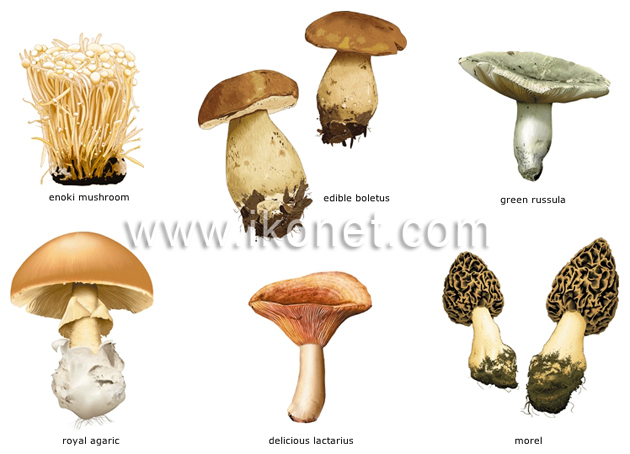
Edible mushrooms: a treat you shouldn’t fear!
There are over 50,000 species of mushrooms, including molds and yeasts. Various types are hallucinogenic, 1 to 2 % of species are poisonous, and others are used for their medicinal properties. Although most mushrooms are edible, few species are actually consumed, as most species can be tough, woody, or gelatinous, give off an unpleasant smell, or taste bad. Only about 20 varieties are truly flavorful.
A number of species can be cultivated, including boletes, pleurotus mushrooms, shiitakes, wood ears and common mushrooms. Truffles are also grown commercially.
Mushrooms are high in potassium and riboflavin, and are believed to have a number of medicinal properties. They are said to be laxative, antibiotic, cholesterol-lowering, and even aphrodisiac.
 Structure of a mushroom
Structure of a mushroom
Common mushroom
The most widely cultivated and consumed mushroom, the common (or cultivated) mushroom is found in various world regions, including North and South America, Europe, Australia and New Zealand. Easily grown, it owns its French name, champignon de Paris, to the fact that it has been cultivated intensively in abandoned quarries around the French capital for about 200 years.
Common mushrooms can be eaten raw or cooked. They are delicious in appetizers, salads, and with dips.
Enoki mushroom
The delicate-tasting enoki mushroom – also called the velvet shank – has a long stem (up to 4 inches tall) topped with a tiny white cap. It grows in clusters on live or dead tree trunks, as well as on tree roots and branches covered with soil.
The enoki mushroom is highly esteemed in Asia and figures prominently in various Asian dishes. About 80 % of world production comes from Japan, where it is called enokitake.
Enoki mushrooms are delicious raw. They add flavor to salads and sandwiches. They are also good in soups.
Truffle
Truffles are hard-to-find edible fungi that grow on the roots of trees, particularly oaks. For a long time, experts had trouble deciding how they grew and how to classify them. People used to believe that truffles sprang up after lightning struck the ground during electrical storms; this myth can be explained by the fact that heavy rains can wash away soil, exposing the highly prized fungi.
Relatively rare, truffles have always been a luxury item. Their gathering, 5 years after the inoculation of the roots on young trees, is done with the help of animals specially trained to recognize the truffle’s odor, such as swine and dogs.
Truffles are eaten raw or cooked, and are also used in the form of juice, concentrate, essence and the like. They are included in a number of products like foie gras and pâté. A few thin slices are enough to flavor an entire dish.
Fresh mushroom and cream salad (4 servings)
- ½ lb (250 g) fresh mushrooms
- 3 shallots
- ¼ cup (60 ml) heavy cream
- juice of ½ lemon
- 3 tbsp. chopped parsley leaves
- salt and ground pepper
- Slice the mushrooms thinly. Place them in a salad bowl and sprinkle them with the lemon juice. Make sure they soak up the juice.
- Finely chop the shallots and add them with the parsley to the mushrooms. Add a generous amount of salt and pepper. Stir.
- Add the cream and stir again. Adjust seasoning to taste.
Serve this salad as a first course. Add more cream if desired.
ALSO SEE

|
The "food and kitchen" section |
|---|---|

|
Infographic: The origins of foods: tasty tales The foods we eat every day come from all around the world and our diet abounds in tasty tales. [...] |

|
Digestion the amazing transformation of food Eating is essential for the body to function. Without the proteins, vitamins, minerals, fats and carbohydrates that we get from food, our body will be about as useful as a car that has run out of gaz. [...] |










